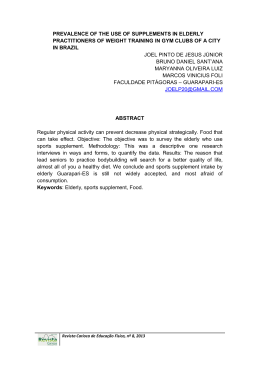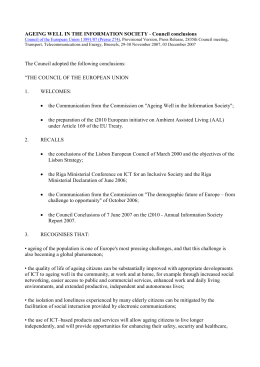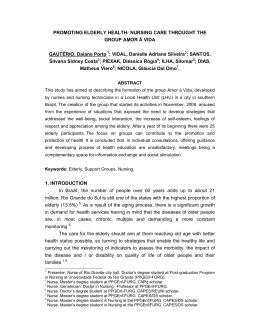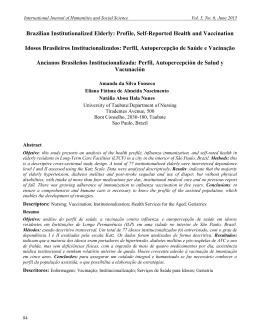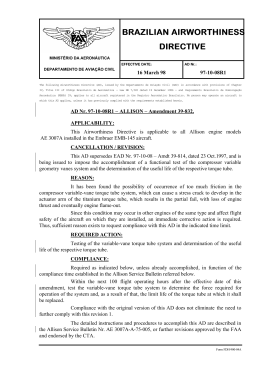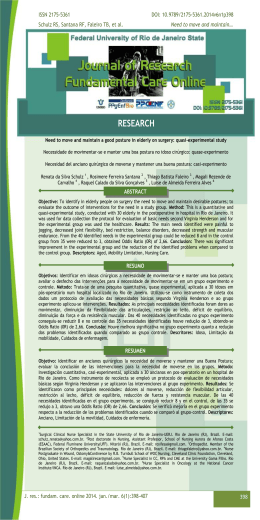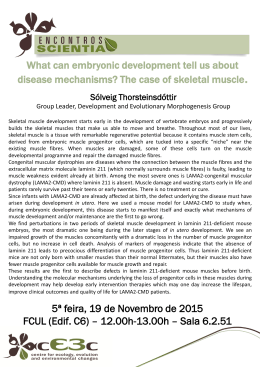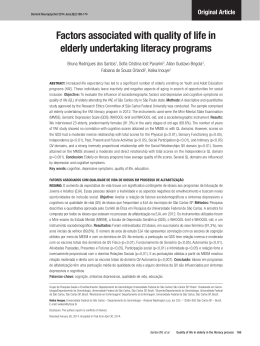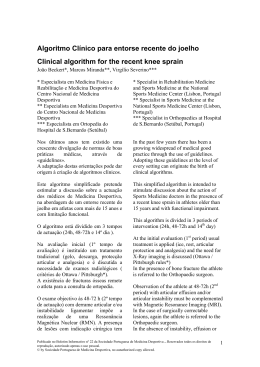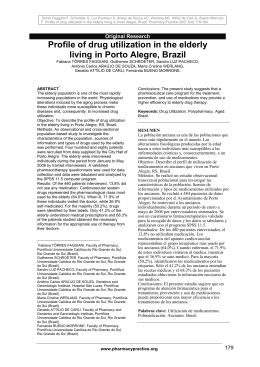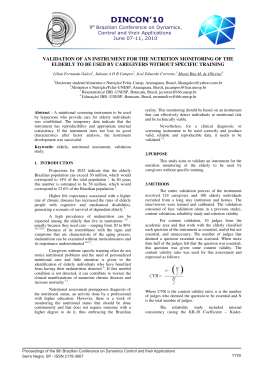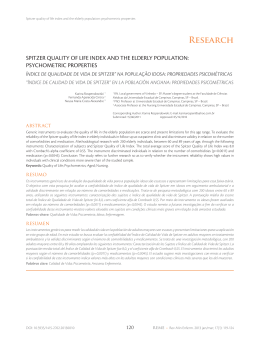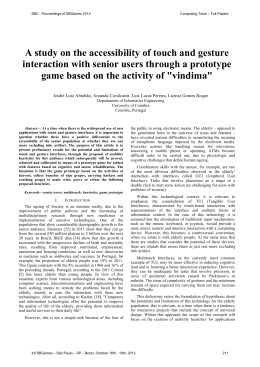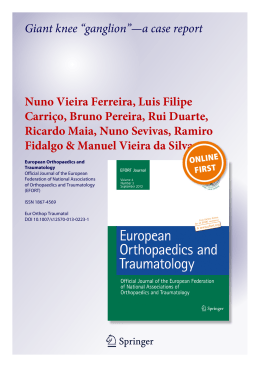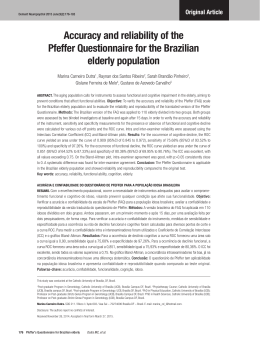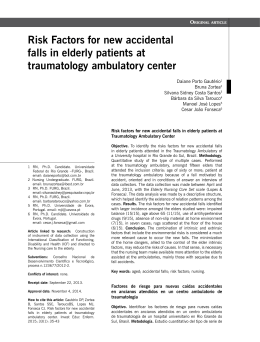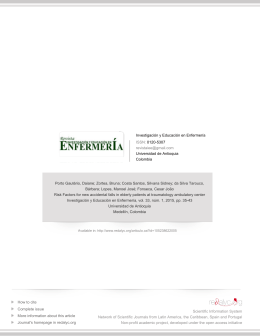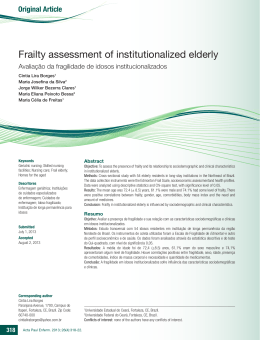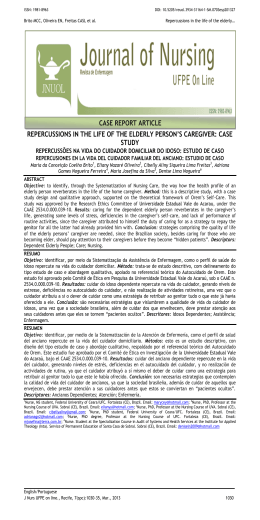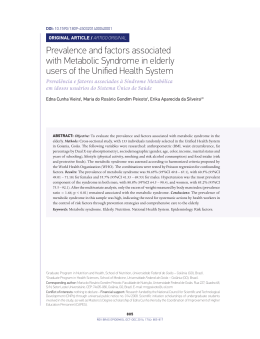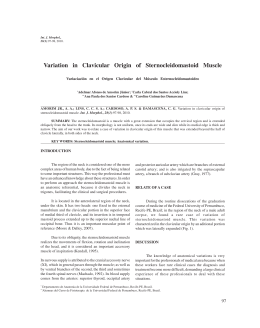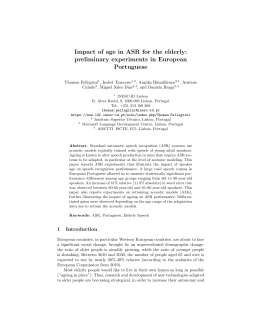Fall Risk Assessment in Elderly with and without history of falls. Strength Analysis of Lower Limb. A comparative study Coutinho, A.(1); Fragata, C.(2); Maio, D.(2); Vivas, I.(2); Gonçalves, M.(2) (1) MSc Physical Therapy. Professor at Superior Helth School Dr. Lopes Dias. Polytechnic Institute of Castelo Branco. Portugal [email protected] (2) Physical Therapist SAMPLE INTRODUCTION Falls in the elderly are a major public concern in terms of morbidity, mortali- Non-probability, convenience, consisted of 30 elderly volunteers ty and costs to health and social services. - WHF Group: 15 individuals with a history of falls; With aging there is a decrease of balance, flexibility, range of motion, neuro- - WOHF Group: 15 individuals without history of falls. INCLUSION CRITERIA motor function and muscle mass. Should be checked which people that are in greater risk of falling, in order to WHF group: maximize the effectiveness of any prevention strategy, this requires knowing - Having ≥ 65 years; the causes and possible risk factors that cause falls. - Having suffered 1 or more falls during the last year; The most important risk factors for falls in the elderly is to highlight the de- - Sign the informed consent. crease in muscle strength and problems with walking and balance. Decreased WOHF group: muscle strength is extremely common among the elderly and is associated - Having ≥ 65 years; with an increased risk of falls. - Have not suffered falls over the past year; A good muscle function of the joints of the hip, knee and ankle, is essential, - Sign the informed consent. EXCLUSION CRITERIA these being key joints in postural control strategies used in an attempt to prevent falls. - Products need to perform gait support; - Possess a condition affecting the lower limbs and/or the gait. MATERIALS AND METHODS - Isokinetic dynamometer Biodex System 3® according to BIODEX Multi-Joint OBJECTIVES System–Pro The aim of this study was to analyse muscle’s performance parameters of - Peak Torque (N.m/kg) flexor and extensor muscles of the knee and ankle of elderly with and without - Ratio flexorcon/extensorcon - Angular speed 60º/s a history of falls. - Five replications http://tuboderetalhos.blogspot.pt/2010/11/medicina-do-esporte-uma-area-em.html http://www.maisquecuidar.com/pt-PT/n/22/PREVENIR-QUEDAS-NOS-IDOSOS_22.htm RESULTS Peak torque per unit mass (N.m/kg) ankle Ratio FlexorsCon/ ExtensorsCon %a nkle Peak torque per unit mass (N.m/kg) knee Ratio FlexorsCon/ ExtensorsCon % knee Movement WOHF WHF p Dorsiflexion 33,61±25,31 32,44±10,31 0,31 Plantar flexion 39,52±14,30 40,04±14,09 0,967 Dominant 116,18±139,53 98,56±72,87 0,443 Flexion 75,39±25,79 69,45±24,28 0,604 Extension 124,66±40,68 111,75±32,33 0,604 Dominant 61,46±11,55 61,86±11,04 0,693 CONCLUSION The group of elderly with history of falls showed lower Peak Torque numbers per unit of mass for the knee and ankle joint comparing with the group without history of falls. In present research also the values of the ratio flexorsCon/ExtensorsCon were analyzed and weren't found any differences in the knee and ankle joints. We conclude that although being similar, because no statistically significant differences were found, the strength for dorsiflexion and knee flexion of the dominant leg is lower for the WHF group therefore we believe it will be beneficial to include strengthening exercises for the flexors and extensors muscles of these joints, thereby contributing to the prevention of falls. BIBLIOGRAPHY American College of Sports Medicine Position Stand. Exercise and physical activity for older adults. Med Sci Sports Exerc. 1998;30(6):992-1008. INE. Censos 2011-Resultados Provisórios 2011. INE. O Envelhecimento em Portugal: Situação demográfica e sócio-económica recente das pessoas idosas. Revista de Estudos Demográficos. 2002. Aquino Mde A, Leme LE, Amatuzzi MM, Greve JM, Terreri AS, Andrusaitis FR, et al. Isokinetic assessment of knee flexor/extensor muscular strength in elderly women. Rev Hosp Clin Fac Koski K, Luukinen H, Laippala P, Kivela SL. Physiological factors and medications as predicMed Sao Paulo. 2002;57(4):131-4. tors of injurious falls by elderly people: a prospective population-based study. Age Ageing. Bento PC, Pereira G, Ugrinowitsch C, Rodacki AL. Peak torque and rate of torque development 1996;25(1):29-38. in elderly with and without fall history. Clin Biomech. 2010;25(5):450-4. Leyk D, Ruther T, Wunderlich M, Sievert A, Essfeld D, Witzki A, et al. Physical performance in Brill PA, Macera CA, Davis DR, Blair SN, Gordon N. Muscular strength and physical function. middle age and old age: good news for our sedentary and aging society. Dtsch Arztebl Int. Med Sci Sports Exerc. 2000;32(2):412-6. 2010;107(46):809-16. Carvalho; J, Oliveira; J, Magalhães; J, Ascensão; A, Mota; J, Soares JMC. Força muscular em Marigold DS, Patla AE. Strategies for dynamic stability during locomotion on a slippery surfaidosos I - Será o treino generalizado suficientemente intenso para promover o aumento da for- ce: effects of prior experience and knowledge. J Neurophysiol. 2002;88(1):339-53. ça muscular em idosos de ambos os sexos? Revista Portuguesa de Ciências do Desporto,. Masud T, Morris RO. Epidemiology of falls. Age Ageing. 2001;4:3-7. 2004;4:51-7. Perry MC, Carville SF, Smith IC, Rutherford OM, Newham DJ. Strength, power output and Chan BK, Marshall LM, Winters KM, Faulkner KA, Schwartz AV, Orwoll ES. Incident fall risk symmetry of leg muscles: effect of age and history of falling. Eur J Appl Physiol. 2007;100 and physical activity and physical performance among older men: the Osteoporotic Fractures (5):553-61. in Men Study. Am J Epidemiol. 2007;165(6):696-703. Pinho L DR, Freire MTF, Tavares CF, Dias JMD. Avaliação isocinetica da função muscular do Crews DE, Zavotka S. Aging, disability, and frailty: implications for universal design. J Physiol quadril e do tornozelo em idosos que sofrem quedas.. Rev Bras Fisioter2005;9:93-9. Anthropol. 2006;25(1):113-8. Rubenstein LZ. Falls in older people: epidemiology, risk factors and strategies for prevention. Deschenes MR. Effects of aging on muscle fibre type and size. Sports Med. 2004;34(12):809Age Ageing. 2006;35(2):ii37-ii41. 24. Siqueira FV, Facchini LA, Piccini RX, Tomasi E, Thume E, Silveira DS, et al. [Prevalence of DGS. Promoção da saúde » Educação para a saúde » Áreas de intervenção » Acidentes e sua falls and associated factors in the elderly]. Rev Saude Publica. 2007;41(5):749-56. prevenção. . 2007; Available from: http://www.dgs.pt/. Skelton DA, Kennedy J, Rutherford OM. Explosive power and asymmetry in leg muscle functiDrouin JM, Valovich-mcLeod TC, Shultz SJ, Gansneder BM, Perrin DH. Reliability and validion in frequent fallers and non-fallers aged over 65. Age Ageing. 2002;31(2):119-25. ty of the Biodex system 3 pro isokinetic dynamometer velocity, torque and position measurements. Eur J Appl Physiol. 2004;91(1):22-9. Vellas BJ, Wayne SJ, Romero LJ, Baumgartner RN, Garry PJ. Fear of falling and restriction of mobility in elderly fallers. Age Ageing. 1997;26(3):189-93. Frontera WR, Hughes VA, Fielding RA, Fiatarone MA, Evans WJ, Roubenoff R. Aging of skeletal muscle: a 12-yr longitudinal study. J Appl Physiol. 2000;88(4):1321-6. WHO. Falls. 2010; Available from: http://www.who.int/mediacentre/factsheets/fs344/en/. Gonçalves; RS, Pinheiro JP. Evolução do Conceito de razão Isquiotibiais/Quadriceps na análi- WHO. What are the public health implications of global ageing? 2006. se da articulação do joelho Revista Portuguesa de Medicina Desportiva. 2003;21:5-10. WHO. WHO Global Report on Falls Prevention in Older Age. 2007. Heitmann DK, Gossman MR, Shaddeau SA, Jackson JR. Balance performance and step width Wolfson L, Judge J, Whipple R, King M. Strength is a major factor in balance, gait, and the ocin noninstitutionalized, elderly, female fallers and nonfallers. Phys Ther. 1989;69(11):923-31. currence of falls. J Gerontol A Biol Sci Med Sci. 1995:64-7.
Download
